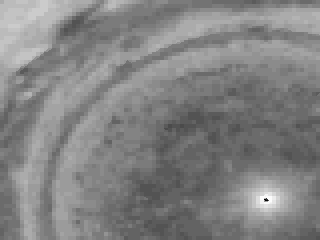
|
Jupiter Polar Winds Movie Blowup
- Click the image above for a larger view
 Movie Download Options
Movie Download Options
Caption:
Persistent polar storms and zonal winds on Jupiter can be seen in this magnified quadrant from a movie projecting images from NASA's Cassini spacecraft as if the viewer were looking down at Jupiter's north pole and the planet were flattened.
The sequence covers 70 days, from October 1 to December 9, 2000. Cassini's narrow-angle camera captured the images of Jupiter's atmosphere in the near-infrared region of the spectrum.
Like the accompanying full-circle movie of polar winds, this zoomed-inversion shows that the polar region has coherent flows, despite its chaotic, mottled appearance. There are thousands of spots, each an active storm similar in size to the largest storms on Earth. The spots occasionally change latitude or merge with each other, but usually they last for the entire 70 days. Until now, the lifetime of those storms was unknown.
The mystery of Jupiter's weather is why the storms last so long. Storms on Earth last for a week before they break up and are replaced by other storms. This movie heightens the mystery because it shows long-lived storms at the highest latitudes, where the weather patterns are more disorganized than at low latitudes.
Cassini collected images of Jupiter for months before and after it passed the planet on December 30, 2000. Six images or more of the planet in each of several spectral filters were taken at evenly spaced intervals over the course of Jupiter's 10-hour rotation period. The entire sequence was repeated generally every other Jupiter rotation, yielding views of every sector of the planet at least once every 20 hours.
The images used for the movie shown here were taken every 20 hours through a filter centered at a wavelength of 756 nanometers, where there are almost no absorptions in the planet's atmosphere. Images from each rotation were assembled first into a cylindrical map. The 84 resulting cylindrical maps, spanning 70 Earth days or 168 Jupiter rotations, were transformed to polar stereographic projections, making a map centered on the north pole. This clip shows detail by zooming in on one quadrant of the full-circle polar projection. Jupiter's alternating eastward and westward jet streams flow in concentric rings around the pole.
Background Info:
For more information, see the Cassini Project home page, http://www.jpl.nasa.gov/cassini/ and the Cassini Imaging Team home page, http://ciclops.lpl.arizona.edu/ciclops/ .
Cassini is a cooperative project of NASA, the European Space Agency and the Italian Space Agency. The Jet Propulsion Laboratory, a division of the California Institute of Technology in Pasadena, manages the Cassini mission for NASA's Office of Space Science, Washington, D.C.
Cataloging Keywords:
| Name | Value | Additional Values |
|---|---|---|
| Target | Jupiter | |
| System | Jupiter | |
| Target Type | Planet | |
| Mission | Cassini-Huygens | |
| Instrument Host | Cassini Orbiter | |
| Host Type | Orbiter | |
| Instrument | Imaging Science Subsystem (ISS) | |
| Detector | Narrow Angle Camera | |
| Extra Keywords | Atmosphere, Grayscale, Infrared, Map, Movie, Rotation, Storm, Visual | |
| Acquisition Date | ||
| Release Date | 2001-07-16 | |
| Date in Caption | 2000-12-09 | 2000-12-30 |
| Image Credit | NASA/JPL/Southwest Research Institute | |
| Source | photojournal.jpl.nasa.gov/catalog/PIA03453 | |
| Identifier | PIA03453 | |
